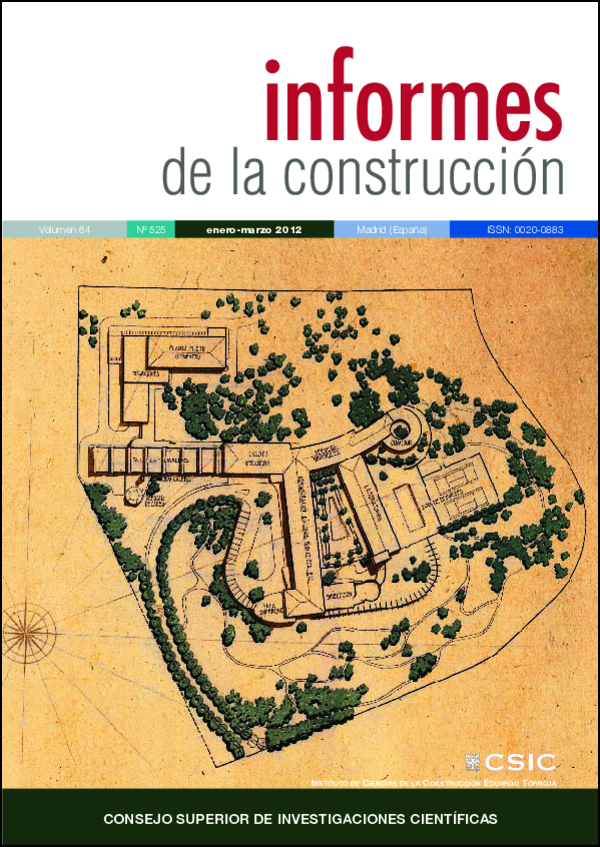A case study: the rehabilitation of residential buildings in La Mina district in Sant Adrià del Besòs (Barcelona). Functional analysis and assessment of safety conditions, habitability and maintenance
DOI:
https://doi.org/10.3989/ic.11.005Keywords:
building rehabilitation, building pathology, reinforced concrete, industrialization, tunnel formworkAbstract
The La Mina district is a public housing development. Consisting of 2727 apartments which were built during the years 1968-74 at the height of the building sector boom, it is characterized by the mixture of building types and building methods employed and is remarkable for the use of the tunnel formwork technique. This paper presents and discusses the contents of the technical study which was prepared as a part of the Plan for Transformation and Improvement of the neighbourhood. The Plan provides for the rehabilitation of buildings and the urban reclassification and social regeneration of the neighbourhood, which is highly stigmatized as a problem area. The functional and structural safety conditions, the level of thermal and acoustic insulation, fire protection, accessibility and maintenance conditions were all analysed in detail in the technical study. In addition, several proposals were put forward for interventions aimed at reducing the most glaring deficiencies.
Downloads
References
(1) Díaz, C.: Aproximació a l’evolució i al comportament derivat de les tècniques constructives utilitzades en els tipus edificatoris exempts destinats a habitatge econòmic a Catalunya (Període 1954-1976), Escola Tècnica Superior d’Arquitectura de Barcelona, Universitat Politècnica de Catalunya, Barcelona, 1986.
(2) Bilbabo, L.: Algunas consideraciones sobre la historia de la industrialización de viviendas durante el Desarrollismo (1960-1975): la aportación bilbaína al debate de la industrialización de la vivienda. Informes de la Construcción, Vol. 58, nº 502 (2006), pp. 59-62.
(3) Avellaneda, J.; González, J. M.; Marques, G.; Vidal, J.: La innovación tecnológica desde la promoción de vivienda pública: el Concurso de Innovación Técnica INCASOL. Informes de la Construcción, Vol. 61 (2009), pp. 87-100.
(4) Cabrera Fernández-Pujol, M.: Encofrados túnel, Sindicato Nacional de la Construcción, Departamento de Industrialización, Madrid, 1975.
(5) Del Águila García, A.: Las Tecnologías de la industrialización de los edificios de vivienda, Colegio Oficial de Arquitectos de Madrid, Madrid, 1986.
(6) High expectations. A guide to the development of concierge schemes and controlled access in high rise social housing, Department of the Environment, Her Majesty’s Stationary Office (HMSO) London, 1994.
(7) Andrade, C.; Feliu, S.: Inspección de obras dañadas por corrosión de armaduras, Manual del Consejo Superior de Investigaciones Científicas, Madrid, 1989.
(8) Díaz, C.; Ferrer. A.; García, R.; Ulla, A.: Els Teixits edificats: transformació i permanència, Revista Papers de l’ Institut d’Estudis Metropolitans de Barcelona, nº 15 (1993).
Downloads
Published
How to Cite
Issue
Section
License
Copyright (c) 2012 Consejo Superior de Investigaciones Científicas (CSIC)

This work is licensed under a Creative Commons Attribution 4.0 International License.
© CSIC. Manuscripts published in both the print and online versions of this journal are the property of the Consejo Superior de Investigaciones Científicas, and quoting this source is a requirement for any partial or full reproduction.
All contents of this electronic edition, except where otherwise noted, are distributed under a Creative Commons Attribution 4.0 International (CC BY 4.0) licence. You may read the basic information and the legal text of the licence. The indication of the CC BY 4.0 licence must be expressly stated in this way when necessary.
Self-archiving in repositories, personal webpages or similar, of any version other than the final version of the work produced by the publisher, is not allowed.















